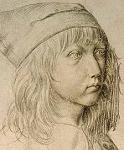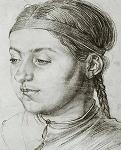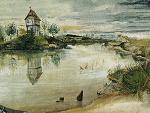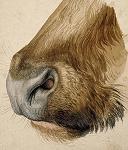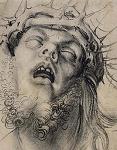
Feature Archive |
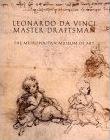 Save 30% on the Exhibition Catalogue |
February, 2003 |
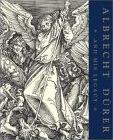 Save 30% on the Exhibition Catalogue |
Art critic Robert Hughes once said that although no writer on art can make people see, he can encourage them to look. This month I'd like to encourage readers to look at the work of Leonardo da Vinci and Albrecht Dürer - two of the supreme visionaries in European art - by going to the excellent online features which accompany the current exhibits of their work in New York and London.
Leonardo da Vinci: Master Draughtsman, at the Metropolitan Museum of Art, New York
Exhibition runs from January 22 through March 30, 2003
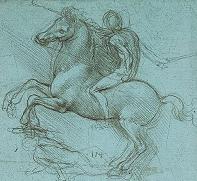 Everybody knows Leonardo da Vinci (1452-1519) is the author of the two most famous paintings in the world: the Mona Lisa and the Last Supper. Yet people are often astonished to learn that he produced fewer than 15 paintings in all.
Everybody knows Leonardo da Vinci (1452-1519) is the author of the two most famous paintings in the world: the Mona Lisa and the Last Supper. Yet people are often astonished to learn that he produced fewer than 15 paintings in all.Leonardo was a painter, sculptor, architect, musician, designer of theatrical entertainments, and a civil and military engineer. He was also one of the greatest natural scientists of all time investigating anatomy, geology, cloud formations, the principles of flight and the motions of the tides. Given all these competing passions it is not at all that surprising that Leonardo found it impossible to devote himself single-mindedly to painting.
Kenneth Clark, in his series Civilization, called Leonardo the most relentlessly curious man who ever lived. Everything he saw made him ask how and why. His motto was: Find out, write it down, and if you can see it, draw it.
His boundless intellectual curiosity was combined with an astonishing talent for seeing and sketching exactly what he saw. Vision was the most important means of understanding the world, and drawing and painting the most important means for describing nature and revealing nature's harmony and order.
The enormous breadth of his mind is manifest in his numerous manuscripts, which were preparations for treatises never completed, and in his working sketches and notebooks, which total many thousand pages.
Leonardo was an untiring draughtsman, and a larger number of his drawings have survived than of any other Renaissance artist. These allow us to follow the continuous process of his growth as an artist and a thinker. The real Leonardo, the full and unabridged universal Renaissance genius, is to be found in these sketches and notebooks.
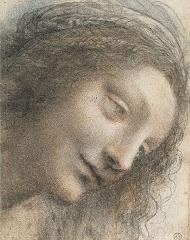 Leonardo da Vinci: Master Draughtsman is the first comprehensive exhibit of these drawings ever presented in America, bringing together almost 120 works on paper as well as one painting.
Leonardo da Vinci: Master Draughtsman is the first comprehensive exhibit of these drawings ever presented in America, bringing together almost 120 works on paper as well as one painting.The Met has developed a "special interactive feature" designed to complement the exhibit: an online tour (really an overview) of the show's eight galleries. This allows us to follow the stages in the development of Leonardo's mind through 34 representative drawings. Each of these can be enlarged several times thanks to a zoom feature. As you click you can even listen to excerpts from the audio guide by the Met Director Philippe de Montebello and the leading Leonardo scholar Sir Martin Kemp.
In addition there are generous excerpts from the print catalogue including the "Leonardo and His Drawings" by the curator Carmen Bambach, and articles on Leonardo's left- handedness and on the Codex Leicester one of his notebooks.
You will find concise and straightforward encyclopedia of information about the techniques, the materials and themes of Renaissance artists by going to the Met's own Timeline of Art History.
If all this makes you hungry to learn more about Leonardo da Vinci pick up a copy of Kenneth Clark's classic study which is still the best written and most discerning short guide to the artist.
Albrecht Dürer and his Legacy, at the British Museum, London
Exhibition runs from December 5, 2002 through March 23, 2003
Appendix: What is a Print?, at the Museum of Modern Art, New York
This is an informative feature about printmaking that was inadvertently left out of last months roundup of favorite online exhibitions. It makes an excellent supplement to the discussion of printmaking in Dürer.
Past Articles
January, 2003
Favorite Online Art Museum Features, by Joseph Phelan
Studies for Masterpieces, by John Malyon
December, 2002
Advent Calendar 2002, narrated by Joseph Phelan
November, 2002
Portrait of the Artist as a Serial Killer, by Joseph Phelan
October, 2002
Renoir's Travelling, Bonnard's "At Home", by Joseph Phelan
September, 2002
The Philosopher as Hero: Raphael's The School of Athens, by Joseph Phelan
August, 2002
The Greatest Works of Art of Western Civilization
July, 2002
Celebrating Heroes; Celebrating Benjamin West, by Joseph Phelan
June, 2002
Chasing the Red Deer into the American Sublime (Education and the Art Museum, Part II), by Joseph Phelan
May, 2002
Planning Your Summer Vacation, by Joseph Phelan
March, 2002
Education and the Art Museum, Part I, by Joseph Phelan
February, 2002
Unsung Griots of American Painting, by Joseph Phelan
January, 2002
The British Museum COMPASS Project, interview by Joseph Phelan
Robert Hughes, Time Magazine Art Critic: Biography and Writings
Lifestyle: Online Casinos Finally Get Real
December, 2001
Software review: Le Louvre: The Virtual Visit on DVD-ROM, by Joseph Phelan
November, 2001
Tragedy and Triumph at Arles: Van Gogh and Gauguin, by Joseph Phelan
October, 2001
Her Last Bow: Sister Wendy in America, by Joseph Phelan
September, 2001
Love, Death and Resurrection: The Paintings of Stanley Spencer, by Joseph Phelan
August, 2001
Who is Rodin's Thinker?, by Joseph Phelan
July, 2001
Celebrations North and South, by Joseph Phelan
June, 2001
Rubens and his Age, by Joseph Phelan
May, 2001
Great Reproductions of Great Paintings
April, 2001
The Passion of Christ, by Joseph Phelan
March, 2001
Edouard Manet: Public Spaces, Private Dreams, by Joseph Phelan
February, 2001
Henry Moore and the British Museum: The Great Conversation, by Joseph Phelan
November, 2000
Article: Notorious Portraits, Part II, by John Malyon
October, 2000
Article: Notorious Portraits, Part I, by John Malyon
Article: The Other Michelangelo, by Joseph Phelan
September, 2000
Article: The Art of Drawing, by Joseph Phelan
August, 2000
Article: Poussin and the Heroic Landscape, by Joseph Phelan
July, 2000
Article: Great Art Museums Online, by Joseph Phelan
June, 2000
Article: Venetian Painting and the Rise of Landscape, by Joseph Phelan
May, 2000
Article: Forbidden Visions: Mythology in Art, by Joseph Phelan
April, 2000
Article: Themes in Art: The Passion of Christ, by Joseph Phelan
Web site review: Christus Rex
March, 2000
Web site review: National Gallery of Art, Washington, D.C., by Joseph Phelan
Online exhibit review: Inuit Art: The World Around Me, by John Malyon
February, 2000/Poll: Who is Producing the Most Interesting Art Today? (Results)
January, 2000/Poll: Who is Producing the Most Interesting Art Today? (Part II)
December, 1999/Poll: Who is Producing the Most Interesting Art Today? (Part I)
November, 1999/The Louvre Museum
Web site review: The Louvre
October, 1999/Impressionism
Web site review: North Carolina Museum of Art
September, 1999/Optical Art
Web site review: The Butler Institute of American Art
August, 1999/Animals in Art
Web site review: National Museum of Wildlife Art
Online exhibit review: PBS: American Visions
July, 1999/Surrealism
June, 1999/Sculpture
Web site review: Carol Gerten's Fine Art
Online exhibit review: Michael Lucero: Sculpture 1976-1995
May, 1999/Women in the Arts
Web site review: National Museum of Women in the Arts
Online exhibit review: Jenny Holzer: Please Change Beliefs
April, 1999/The Golden Age of Illustration
Web site review: Fine Arts Museums Of San Francisco
Online exhibit review: Treasure Island and Robinson Crusoe online
March, 1999/Vincent van Gogh
Web site review: Van Gogh Museum, Amsterdam
Web site review: The Vincent van Gogh Information Gallery
February, 1999/Great Art
Web site review: The State Hermitage Museum, St. Petersburg, Russia
Online exhibit review: John Singleton Copley: Watson and the Shark
